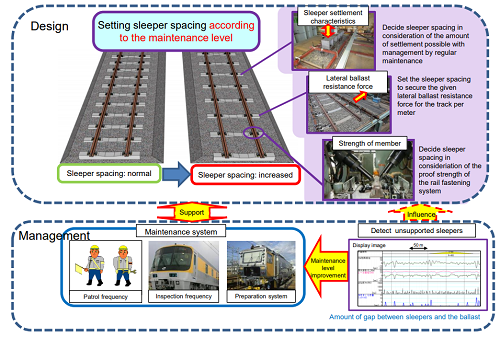10. Method to design and manage ballasted tracks equivalent to an increase in the spacing of sleepers
Some railway operators have started to look at increasing the spacing of sleepers for ballasted tracks as a measure to reduce the cost of railway track maintenance for regional railways.
However, since there are concerns regarding the rapid rate of track settlement depending on the track bed and ballast layer conditions, as well as adverse effects on vehicle-running safety due to problems including local unsupported sleepers and rail fastener failures, the establishment of a design method is required.
Therefore, a method to design and manage ballasted tracks has been proposed equivalent to an increase in the spacing of sleepers for regional railways.
The following is an outline of this method.
(1) Calculate the lateral ballast resistance force corresponding to the increased spacing of sleepers as well as the track settlement amount under the condition of ballast mixed with finegrained soil.
(2) Calculate the effect of the rail fastening system design according to common usage conditions and examine the strength of the members.
(3) Use the newly developed unsupported sleeper detection method (a method to detect unsupported sleepers by calculating the values from track irregularity data and track specifications) and determine the control index to secure running safety.
The procedures above enable the calculation of the optimum spacing of sleepers possible to maintain running safety according to the maintenance system of each section including the level and frequency of track maintenance and patrol frequency.
Please note that the developed unsupported sleeper detection method is incorporated in the railway track maintenance management database system (LABOCS). The proposed design and management method will be reflected in the design standards.

